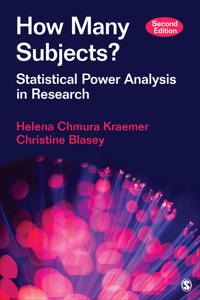
endast ny
How Many Subjects? Upplaga 2
With increased emphasis on helping readers understand the context in which power calculations are done, this Second Edition introduces a simple technique of statistical power analysis that allows researchers to compute approximate sample sizes and power for a wide range of research designs. Because the same technique is used with only slight modifications for different statistical tests, researchers can then easily compare the sample sizes required by different designs and tests to make cost-effective decisions in planning a study. These comparisons demonstrate important principles of design, measurement, and analysis that are rarely discussed in courses or textbooks, making this book a valuable instructional resource as well as a must-have guide for frequent reference.
New to this edition:
Power computations are now placed in the proper context as one small but crucial step in applying the scientific method.
The number of tests to which the methods can be applied has been extended.
The book now incorporates the authors’ experience where errors in design and interpretation of statistical hypothesis testing occur.
Recent emphasis on effect sizes rather than p-values is endorsed and emphasized throughout.
Recent developments in consideration of moderators and mediators are acknowledged.
Upplaga: 2a upplagan
Utgiven: 2015
ISBN: 9781483319544
Förlag: SAGE Publications, Inc
Format: Häftad
Språk: Engelska
Sidor: 160 st
With increased emphasis on helping readers understand the context in which power calculations are done, this Second Edition introduces a simple technique of statistical power analysis that allows researchers to compute approximate sample sizes and power for a wide range of research designs. Because the same technique is used with only slight modifications for different statistical tests, researchers can then easily compare the sample sizes required by different designs and tests to make cost-effective decisions in planning a study. These comparisons demonstrate important principles of design, measurement, and analysis that are rarely discussed in courses or textbooks, making this book a valuable instructional resource as well as a must-have guide for frequent reference.
New to this edition:
Power computations are now placed in the proper context as one small but crucial step in applying the scientific method.
The number of tests to which the methods can be applied has been extended.
The book now incorporates the authors’ experience where errors in design and interpretation of statistical hypothesis testing occur.
Recent emphasis on effect sizes rather than p-values is endorsed and emphasized throughout.
Recent developments in consideration of moderators and mediators are acknowledged.
Ny bok
560 kr589 kr
5% studentrabatt med Studentapan
Begagnad bok (0 st)
Varje vecka tillkommer tusentals nya säljare. Bevaka boken så får du meddelande när den finns tillgänglig igen.



